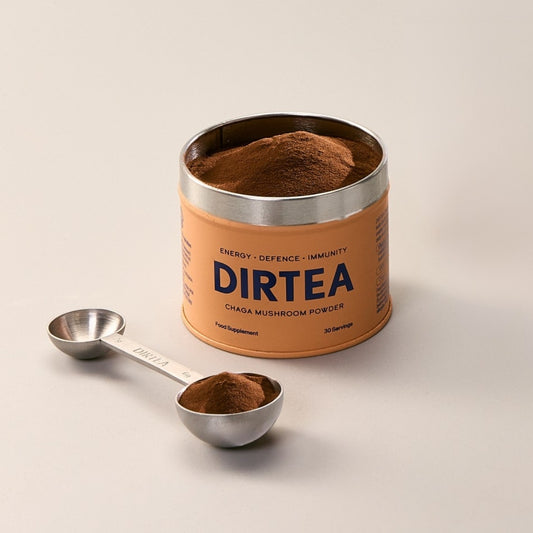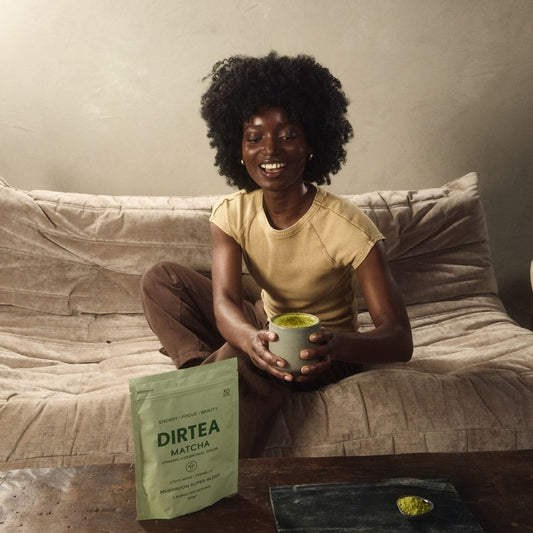S.A.D & Seasonal Shifts: Mood, Light and Rituals for the Darker Months

Share
When the Darker Months Take a Toll
As autumn fades into winter, the darker days can feel heavy. Many people experience changes in mood, energy, and sleep during this time, sometimes developing Seasonal Affective Disorder (S.A.D.) - a type of depression linked to reduced daylight hours.
According to Conde Nast Traveller, in the UK, it’s estimated that around 2 million people experience S.A.D. Reviews suggest that S.A.D. is relatively common in temperate regions, with a prevalence typically ranging from 2–5%. Rates rise in higher latitudes, sometimes approaching 10%. Symptoms often include fatigue, low mood, carbohydrate cravings, and difficulty concentrating.
While light therapy and medical support remain the gold standard treatments, lifestyle rituals play a huge role in managing seasonal shifts. Functional mushrooms and adaptogen-rich blends, when incorporated into a holistic routine, may support mood, energy, and resilience during the darker months.
Understanding S.A.D. and Seasonal Shifts
S.A.D. is thought to be linked to:
- Reduced sunlight exposure → disrupting circadian rhythms and melatonin
production. Research supports that daylight sets our body clock (via special light-sensing cells in the eye), lifts mood and thinking, supports vitamin D and healthy eye development, and is used in light therapy for depression and sleep problems. - Lower serotonin activity → affecting mood regulation.
- Vitamin D deficiency → more common in winter months, which may contribute to
fatigue and low mood.
Even those without a clinical diagnosis often report feeling “slowed down” in the colder seasons.
This is where rituals come in - simple, repeatable practices that create grounding and bring light into the darker months.
The Role of Rituals in Winter Wellness
Functional mushrooms have long been used to help the body adapt to stress and maintain balance. While they are not a treatment for S.A.D., they can form part of a supportive wellness routine.
Here’s how DIRTEA’s Super Blends fit into seasonal rituals:
1. DIRTEA Cacao - Calm & Comfort for Colder Nights
Rich, smooth, and naturally chocolatey, DIRTEA Cacao combines Reishi (for calm and relaxation) with Lion’s Mane (for focus), Tremella (for skin), and a B-vitamin complex. Perfect for winding down, it helps create an evening ritual that signals the body it’s time to rest.
- Why in winter? Studies suggest warm, soothing drinks can psychologically aid relaxation and comfort, supporting better sleep quality. Reishi’s triterpenes and polysaccharides have also been traditionally used to support sleep.
2. DIRTEA Chai – A Cosy Afternoon Reset
Spiced with warming flavours like cinnamon and cardamom, DIRTEA Chai blends Reishi, Lion’s Mane, Reishi, and Tremella, along with adaptogenic herbs such as Ashwagandha. It’s caffeine-free, making it ideal for afternoons when you want to recharge without disrupting sleep.
- Why in winter? Ashwagandha is an adaptogen traditionally used to help the body adapt to stress and support overall balance and well-being. Pairing it with mushroom extracts makes Chai a grounding, comforting option for darker afternoons.
3. DIRTEA Matcha – Light in the Morning Darkness
Winter mornings can feel particularly heavy. DIRTEA Matcha, powered by Lion’s Mane and a B-vitamin complex, delivers steady caffeine alongside L-theanine - an amino acid that supports calm alertness.
- Why in winter? Research shows that green tea catechins and L-theanine may support focus and reduce stress markers. For those struggling with morning sluggishness, Matcha can feel like a gentle, sustained wake-up light.
4. DIRTEA Coffee – Energy and Resilience
For many, coffee is a non-negotiable ritual. DIRTEA Coffee simply goes further - pairing smooth coffee with Lion’s Mane and a B-vitamin complex - to complement caffeine with a clear, balanced feel.
- Why in winter? Darker mornings and shorter days can sap motivation. A steady coffee ritual helps set the tone for the day, while B vitamins contribute to normal energy-yielding metabolism, and Lion’s Mane has a long history of traditional use for mental clarity - making your morning cup feel a little more focused and consistent.
Building a Winter Wellness Routine
Here’s a sample adaptogen-powered daily rhythm to manage seasonal shifts:
- Morning: Step outside for natural light, then sip DIRTEA Matcha or Coffee for focused energy.
- Afternoon: Take a break with DIRTEA Chai, pairing it with mindful movement (stretching, a walk).
- Evening: Create a cosy ritual with DIRTEA Cacao, dimmed lights, and screen-free time.
Layering these blends into your day not only supports energy, calm, and immunity but also creates rhythms of joy in the darker months.
Other Natural Ways to Support Mood in Winter
Alongside mushroom rituals, other evidence-based practices may help reduce S.A.D. symptoms:
- Light Therapy: Bright light boxes mimicking daylight are clinically recommended for S.A.D.
- Vitamin D Supplementation: Deficiency is widespread in winter, especially in northern latitudes.
- Movement: Exercise has well-documented antidepressant effects.
- Sleep Hygiene: Consistency in sleep and wake times regulates the circadian rhythm.
- Social Connection: Sharing meals or rituals with others counters isolation.
Finding Light in the Darker Months
S.A.D. and the winter blues are real challenges that affect millions each year. While medical support and light therapy remain central, rituals - especially those built around adaptogens and functional mushrooms - offer daily grounding and gentle resilience.
Whether it’s sipping DIRTEA Matcha to brighten dark mornings, Chai to reset in the afternoon, or Cacao to unwind in the evening, these rituals bring warmth, balance, and a sense of comfort when daylight feels scarce.
By embracing supportive habits, nourishing your body, and creating mindful rituals, the darker months don’t have to feel so heavy - they can become a season of grounding, reflection, and inner light.
References
- Kleeman, T. (2023, October 4). Goodbye summer: What to do if the changing seasons are impacting your mental health. Condé Nast Traveller. Retrieved from https://www.cntraveller.com/article/how-the-changing-seasons-can-impact-your-mental-health
- Fonte, A., & Coutinho, B. (2021). Seasonal sensitivity and psychiatric morbidity: Study about seasonal affective disorder. BMC Psychiatry, 21(1), 317. https://doi.org/10.1186/s12888-021-03313-z
- Wirz-Justice, A., Skene, D. J., & Münch, M. (2021). The relevance of daylight for humans. Biochemical Pharmacology, 191, 114304. https://doi.org/10.1016/j.bcp.2020.114304
























